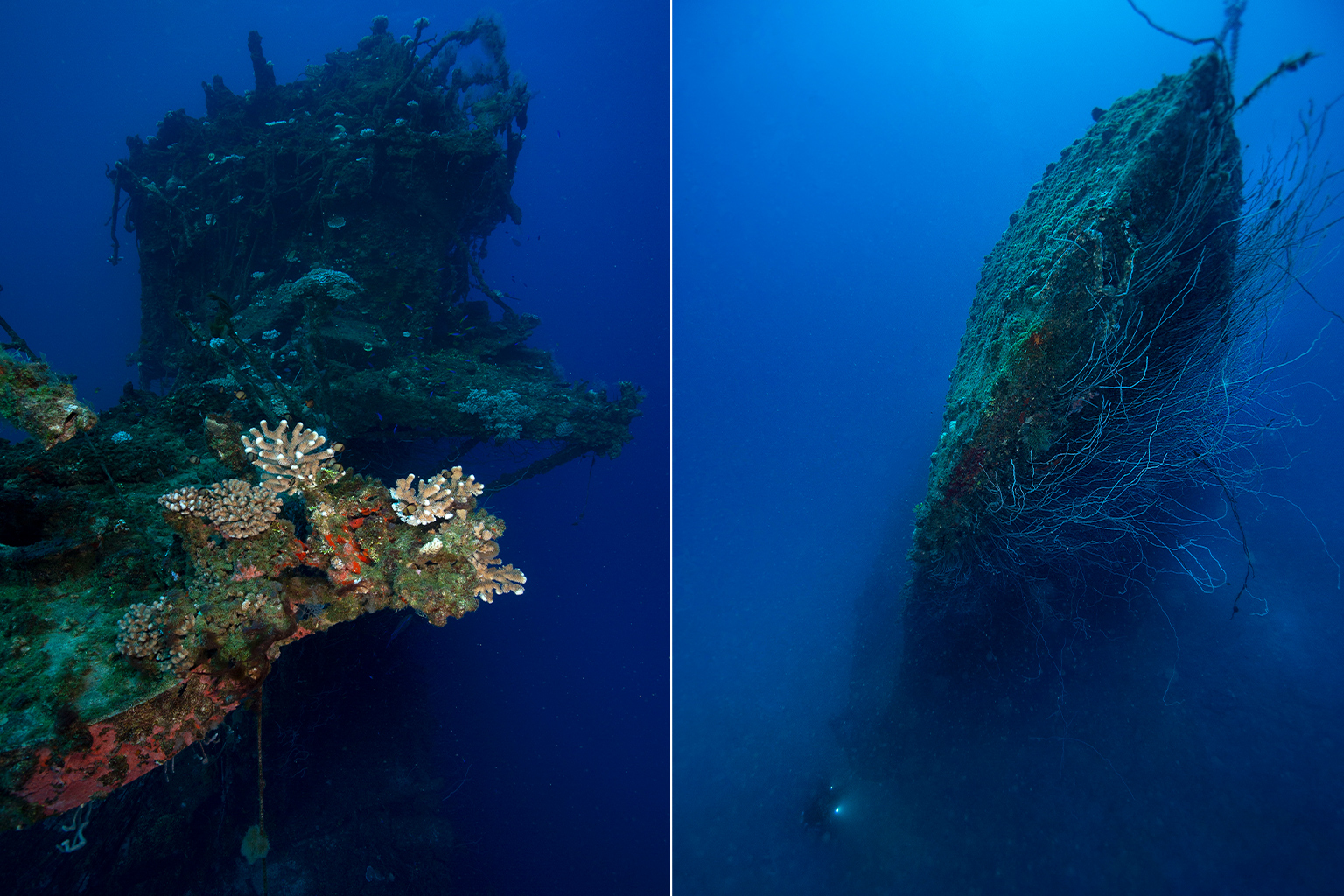- Researchers surveyed 29 warships at Bikini Atoll and Chuuk Lagoon and found that they hosted up to a third of coral genera found on natural reefs in neighboring regions.
- This study has led researchers to ask a controversial question: Can these kinds of shipwrecks act as biodiversity havens for corals?
- While the study does not provide an answer to this question, the authors say this idea should be explored.
- Climate change is one of the biggest threats to coral reefs since rising temperatures can cause widespread bleaching events.
On May 25, 1946, the United States detonated the first underwater nuclear bomb at Bikini Atoll in the Marshall Islands to see what kind of damage it would cause. This particular bomb, known by the codename “Baker,” sank eight warships that had been deliberately positioned around the atoll, and produced a giant mushroom cloud that inundated the sea and sky.
While Bikini Atoll is still radioactive, the surrounding ocean hasn’t become the nuclear wasteland one might expect. Many coral species have proved to be resilient to this large-scale anthropogenic disturbance, and corals have also settled on the sunken warships that have been rusting on the seafloor for more than 70 years.
In 2018, ecologist Greg Asner and a team of divers began a survey of the coral on the warships at Bikini Atoll as well as the sunken Japanese fleet of Truk (Chuuk) Lagoon in Micronesia, in an effort to answer a question: could these reefs act as biodiversity havens? This question has become particularly relevant as the global oceans heat up as a result of climate change, causing widespread coral bleaching from which many natural reefs are unable to recover.

Asner and his team undertook a series of deep dives to survey the stony coral species on 29 warships at Bikini Atoll and Chuuk Lagoon, most of them at a depth of about 55 meters (180 feet). This depth meant that the divers could only stay underwater for short periods of time, so instead of identifying the corals while underwater, they took 8K video and analyzed the footage on land. This identification process was an arduous task, Asner said, since many coral species look very similar.
In a new paper, Asner and his colleagues reported that Bikini had about 67% of the coral genera found on nearby natural reefs, while Chuuk had 72% of the genera of natural reefs. The team also identified 34 coral genera at Bikini and 51 genera at Chuuk. The bigger the shipwreck, the more biodiversity they found.
“What was surprising about the ships wasn’t the total number of corals … but it was the diversity,” Asner told Mongabay. “How many different corals had made their homes on these shipwrecks was the shocking part.”
Study co-author Robin Martin, a technical diver who helped orchestrate the deep dives needed to complete these surveys, said there was more richness at shallower depths, but that there was still a diversity of species further down.
“It’s truly amazing to be really deep and still find different species all over the ships,” Martin told Mongabay.
Corals that are positioned deeper in the ocean are more protected from marine heat waves that can cause bleaching, Asner said. However, there’s debate as to whether deeper coral reefs will remain unscathed as the oceans heat up.


So can artificial reefs like the warships at Bikini Atoll and Chuuk Lagoon provide “havens” for coral reefs in the face of climate change, and even help corals migrate to more habitable parts of the ocean as temperatures rise? The authors note that this is a controversial question, but one that should be explored.
“We don’t want to go overboard, but it’s a neat finding,” Asner said. “And it gives us some sense that there’s more out there than we know.”
According to the paper, artificial reefs have sprung up around some 2,000 shipwrecks around the world, and the coral diversity on these ships is “virtually unknown.” Asner said this study is part of a larger project that identifies coral communities previously unknown to science.
Maria Beger, a coral reef ecologist and conservation scientist at the University of Leeds, who was not involved in this study, but has studied coral reefs in Bikini and Chuuk, said this research is exciting since very little is known about coral reef habitats in this deeper band of water, known as mesophotic coral ecosystems, and also about coral reefs in the Micronesian region in general.
However, she said the question of whether shipwrecks like the ones found at Bikini Atoll and Chuuk Lagoon can act as safe havens may be “the wrong question to ask.”
“The question is, why do we need those safe havens on a shipwreck? Why can’t we have our biodiversity on the reef in Chuuk or in Bikini?” Beger told Mongabay. “And let’s not forget that those reefs and those atolls … have symbolism for war and nuclear testing and shifting people off their native islands.”
While Beger said the shipwrecks at Bikini and Chuuk are great dive sites that host an important amount of biodiversity, we should first and foremost be looking at ways to protect the natural reefs. “We can’t see shipwrecks as a get-out clause for real reef protection,” she said.

Banner image: Divers examine the corals on shipwrecks at Bikini Atoll. Image courtesy of Greg Asner.
Citations:
Asner, G. P., Giardina, S. F., Balzotti, C., Drury, C., Hopson, S., & Martin, R. E. (2022). Are sunken warships biodiversity havens for corals? Diversity, 14(2), 139. doi:10.3390/d14020139
Richards, Z. T., Beger, M., Pinca, S., & Wallace, C. C. (2008). Bikini atoll coral biodiversity resilience five decades after nuclear testing. Marine Pollution Bulletin, 56(3), 503-515. doi:10.1016/j.marpolbul.2007.11.018
Elizabeth Claire Alberts is a staff writer for Mongabay. Follow her on Twitter @ECAlberts.
FEEDBACK: Use this form to send a message to the author of this post. If you want to post a public comment, you can do that at the bottom of the page.
